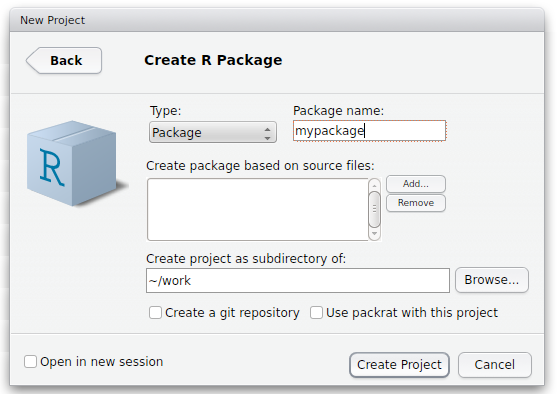Makes your code:
Easier to manage
Easier to reuse
Easier to share
Damjan Vukcevic
Lecturer in Statistical Genomics
Makes your code:
Easier to manage
Easier to reuse
Easier to share
What is an R package?
Your first R package
Developing R packages using RStudio
"Packages are the fundamental units of reproducible R code." (Hadley Wickham)
"R packages are the best way to distribute R code and documentation…" (Karl Broman)
Functions are an even more 'fundamental unit' than packages
The simplest way to 'package up' some R code
Define a function:
# Calculate the square of x.
square <- function(x)
x^2
Use the function:
square(1:3)
## [1] 1 4 9
…a standard way to 'package up' R functions together
R code ➔ functions ➔ packages
functions.R, the poor man's R packagePlace function definitions in a file called functions.R
Load this in other scripts using source("functions.R")
In functions.R:
# Calculate the square of x.
square <- function(x)
x^2
In your R session:
source("functions.R")
square(1:3)
## [1] 1 4 9
In functions.R:
# Resample values from a given vector.
resample <- function(x, ...)
x[sample.int(length(x), ...)]
In your R session:
source("functions.R")
resample(letters[1:10])
## [1] "c" "h" "d" "a" "i" "e" "g" "j" "f" "b"
source() onceIn your R session:
source("functions.R")
square(1:3)
## [1] 1 4 9
resample(letters[1:10])
## [1] "d" "i" "c" "e" "f" "g" "h" "a" "j" "b"
Hilary Parker:
I really should just make an R package with these functions so I don't have
to keep copy/pasting them like a goddamn luddite.
Create folder structure
mypackage/
└── R/
Move functions.R into the R subfolder
mypackage/
└── R/
└── functions.R
Create the DESCRIPTION and NAMESPACE files
mypackage/
├── R/
│ └── functions.R
├── DESCRIPTION
└── NAMESPACE
Note: RStudio will automatically create these files
Your DESCRIPTION file should look similar to:
Package: mypackage
Title: This is my first R package
Description: This package was created as a way to learn how to write
R packages.
Authors@R: person("Damjan", "Vukcevic", email = "damjan@vukcevic.net",
role = c("aut", "cre"))
Version: 0.1
Depends: R (>= 3.3.1)
License: GPL-3
LazyData: true
Your NAMESPACE file should look like:
# Export all names
exportPattern("^[[:alpha:]]+")
Now, let's do all of this in RStudio…
File > New Project… > New Directory > R Package > (dialog box) > Create Project

Edit the DESCRIPTION file
Edit your code
Simply use library(mypackage) instead of source("functions.R")
For example:
library(mypackage)
square(1:3)
## [1] 1 4 9
resample(letters[1:10])
## [1] "f" "b" "a" "c" "e" "g" "i" "h" "d" "j"
You can split up your code into any number of .R files
mypackage/
├── R/
│ ├── resample.R
│ └── square.R
├── DESCRIPTION
└── NAMESPACE
All .R files within the R subfolder will automatically be included
in your package
(More convenient than if source()-ing)
functions.R)
And also (not covered today):
https://dvukcevic.github.io/rpkgs-talk-resbaz2018/
https://dvukcevic.github.io/rpkgs-talk/
Web - http://damjan.vukcevic.net/
Email - damjan@vukcevic.net
Twitter - @VukcevicD
Write an R package called challenge1 that contains the functions square()
and cube() which respectively square or cube an input number.
Write an R package called challenge2 that contains the functions
fullname() and sentence() that behave as follows:
fullname() combines two input strings into a single string, for example:
fullname("Damjan", "Vukcevic") should return "Damjan Vukcevic".
sentence() takes two input strings and returns a sentence, in this form:
sentence("Damjan", "Vukcevic") should return "The name Damjan Vukcevic
contains 14 characters".
Hint: use paste() and nchar()